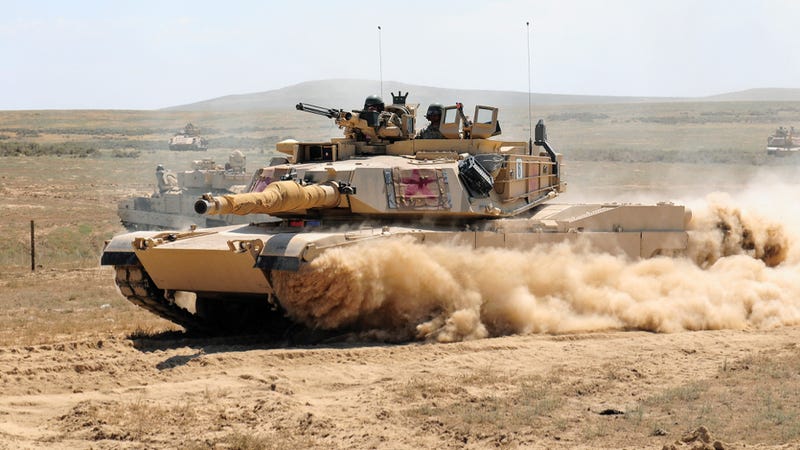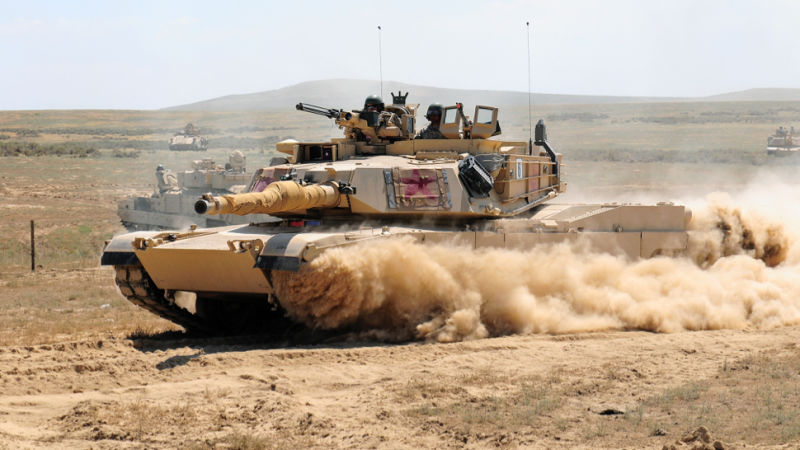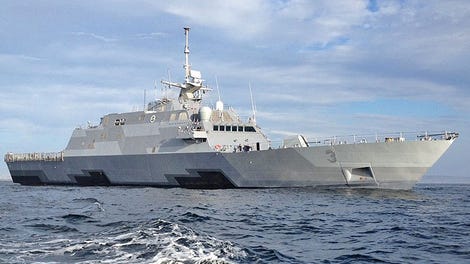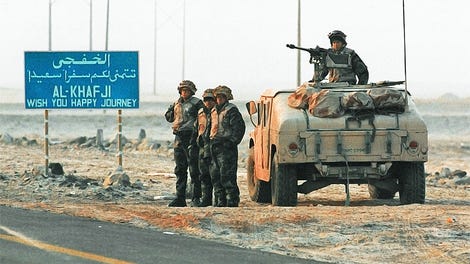
President Donald Trump is celebrating a ten-year, $350 billion arms deal with Saudi Arabia he announced over the weekend during his visit in Riyadh; $110 billion of that figure will take affect immediately. Here’s what $110 billion dollars in nothing but the finest American weapons gets you these says.
The U.S. State Department said in a written statement that the arms package “supports the long-term security of Saudi Arabia and the Gulf region in the face of malign Iranian influence and Iranian related threats.” Besides protecting itself against Iran, the arms deal, which include tanks, helicopters, ships and other kinds of hardware will strengthen Riyadh’s ability to protect itself, relieving U.S. forces of the burden to some degree.
There is no official itemized list of arms connected to the $110 billion sum, but it appears that Lockheed Martin, Boeing and Raytheon are the biggest beneficiaries. Lockheed Martin said in a statement that the Saudi Arabia will procure “more than $28 billion worth of Lockheed Martin integrated air and missile defense, combat ship, tactical aircraft and rotary wing technologies and programs.” Boeing and Raytheon also released statements, but did not specify how much money they expect to earn from the deal.
Advertisement
A state department official forwarded Foxtrot Alpha this link of letters of offer and acceptance when we asked for details related to the arms deal. White House officials told The National Interest that details on the exact nature of what will be sold told the Saudis are still being ironed out, but it will likely be “a mix of direct commercial sales and foreign military sales contracts.”
Based on the memorandum of intent items outline in the link the State Department sent us, we itemized some of the big ticket items the Saudis are expecting. This is a partial list.
Tanks
Saudi Arabia is expecting 153 M1A1/A2 tank structures, which will be turned into 133 Saudi-specification M1A2S main battle tanks. Twenty additional tanks will replace those from the Saudis fleet that were lost in combat, possibly against Yemen. The tank sale also comes with M88A1/A2 Heavy Equipment Recovery Combat Utility Lift Evacuation System (HERCULES) – think of that like a tow truck for tanks – along with additional equipment, training, and support, according to the State Department. That tallies up to around $1.5 billion.
Sponsored
The M1A2 is an improvement on the M1A1, and a significant exterior change from the original includes the re-designed Commander’s Weapon Station (CWS). Here’s some of what’s on the inside, per military.com:
Most notable of these improvements is the addition of the Inter-Vehicle Information System (IVIS.) The IVIS system allows for the automatic and continual exchange of information between vehicles. By incorporating information provided by an on board Position/Navigation (POSNAV) system, unit commander’s can track the location and progress of subordinate elements automatically, without tasking vehicle crews. In addition enemy positions can be identified, plotted and disseminated, while reports and artillery requests can be automatically formatted, transmitted, and processed. Lastly, map graphic control measures and operational orders can be rapidly distributed via the IVIS system.
The M1A2 is arguably one of the the most sophisticated tanks the world, and it’s much more advanced than Iran’s Karrar, that’s for sure.
HERCULES is an armored recovery vehicle (ARV) designed to evacuate, recover, repair tanks on the battlefield. They are equipped with a .50 caliber machine gun, with 1,300 rounds. The ARV can also take small arms fire, anti-personnel mines and artillery fragments. It has a 35-ton boom, and a 140,000 pound constant-pull main winch, making it more than capable of pulling an M1A2S.
And because nothing in life is complete without optional extras, it also comes with:
Advertisement
One hundred fifty-three (153) M2 .50 Caliber Machine Guns; two hundred sixty-six (266) 7.62mm M240 Machine Guns; one hundred thirty-three (153) M250 Smoke Grenade Launchers; twenty (20) M88A l/A2 Heavy Equipment Recovery Combat Utility Lift Evacuation System (HERCULES) Armored Recovery Vehicle (ARV) Structures for conversion to twenty (20) M88Al/A2 HERCULES ARVs; one hundred sixty-nine (169) AN/VAS-5 Driver Vision Enhancer-Abrams (DVE-A); one hundred thirty-three (133) AN/PVS-7B Night Vision Devices; four thousand two hundred fifty-six (4,256) Rounds M865 Training Ammunition; and two thousand three hundred ninety-four (2,394) Rounds M831Al Training Ammunition
We know, all of this stuff has been on your birthday wishlist, too. Maybe next year.
Helicopters
Riyadh will get around 48 CH-47F Chinook cargo helicopters, along with 112 Lycoming T55-GA-714A engines that the Chinooks use, 58 AN/AAR-57 Common Missile Warning Systems, and 48 M240H 7.62mm machine guns with spare parts and other hardware, totaling $3.51 billion.
Advertisement
In addition to the CH-47F Chinook being able to carry 33 troops plus three crew, with a maximum gross weight of 50,000 pounds and maximum cruise speed of 160 knots, here is more on the the chopper:
The CH-47F Chinook is the Army’s only heavy-lift cargo helicopter supporting combat and other critical operations. The CH-47F has a suite of improved features such as an upgraded digital cockpit featuring the Common Avionics Architecture System, a new monolithic airframe with vibration reduction, and the Digital Automatic Flight Control System, which provides coupled controllability for operations in adverse environments (reduced visibility, brown out, high winds). The CH-47F’s common cockpit enables multiservice digital compatibility and interoperability for improved situational awareness, mission performance and survivability, as well as future growth potential. The CH-47F can lift intra-theater payloads up to 16,000 pounds in high/hot environments.
And even though it’s one of the largest helicopters Saudi use, the Chinook is also one of the fastest. That’s what you get when you have two main rotors.
THAAD
Perhaps the most controversial missile defense system in the world, Terminal High Altitude Area Defense, or THAAD, will be sold to Saudi Arabia, per The National Interest. Foxtrot Alpha has written extensively on THAAD, particularly its deployment to South Korea to protect the nation from a potential strike from North Korea.
It is able to intercept short, medium, and intermediate range ballistic missiles in their terminal phase, and as such makes it highly attractive to a country like Saudi Arabia, which is situated in a part of the world where missiles seem to start flying on the regular. Though there are plenty of critiques about the system, it is highly advanced and would be a powerful addition to Saudi Arabia’s ballistic missile defense.
Ships
The Saudis may be getting some “Multi-Mission Surface Combatants,” or MMSC ships, which are based on the Freedom-class Littorial Combat Ship primarily built by Lockheed Martin. It has a nautical range of 5,000 miles and can go as far as 30 knots per hour. Here is more on the ship:
Advertisement
Advertisement
The MMSC utilizes the COMBATSS-21 Combat Management System, built from the Aegis Combat System Software library. The MMSC integrated combat system solution leverages the domestic LCS integration of the 57mm Mk110 deck gun and SeaRAM, and expands multi-mission capability through integration of Over-The-Horizon surface-to-surface missiles, port and starboard 20 mm remote guns, a new fire control radar and a forward centerline 8 cell MK 41 Vertical Launch System equipped with RIM-162 Evolved Sea Sparrow Missiles. The MMSC is also equipped with the AN/SLQ-25 Torpedo Defense system.
Additionally, the deal also includes job training for Saudi citizens and infrastructure improvements. General Electric “signed memorandums of understanding for the sale of $7 billion of GE technology and for the training of Saudi citizens in cloud-based data skills and expertise in the health-care industry,” per The Washington Post.
There are some more details to consider here. For one, many of these requests from the Saudis took place over several years before Trump won office in November, so it is not as if he brokered all of these deals between the various companies at once over several days or even during his total time in office.
Advertisement
But it’s not like this will truly change the balance of power in the Middle East. Sure, it seems like a massive arms deal, but truth be told Saudi Arabia – and for what it’s worth, much of the entire region – has been backed by Western weapons for decades. All of this just makes sure that the wheel doesn’t stop turning, and Saudi Arabia knows where its next gun is coming from.
















